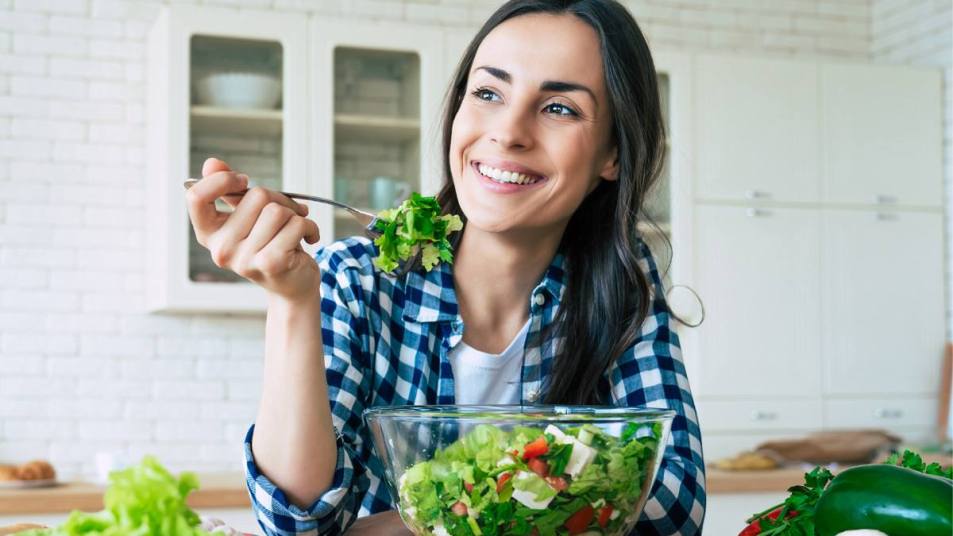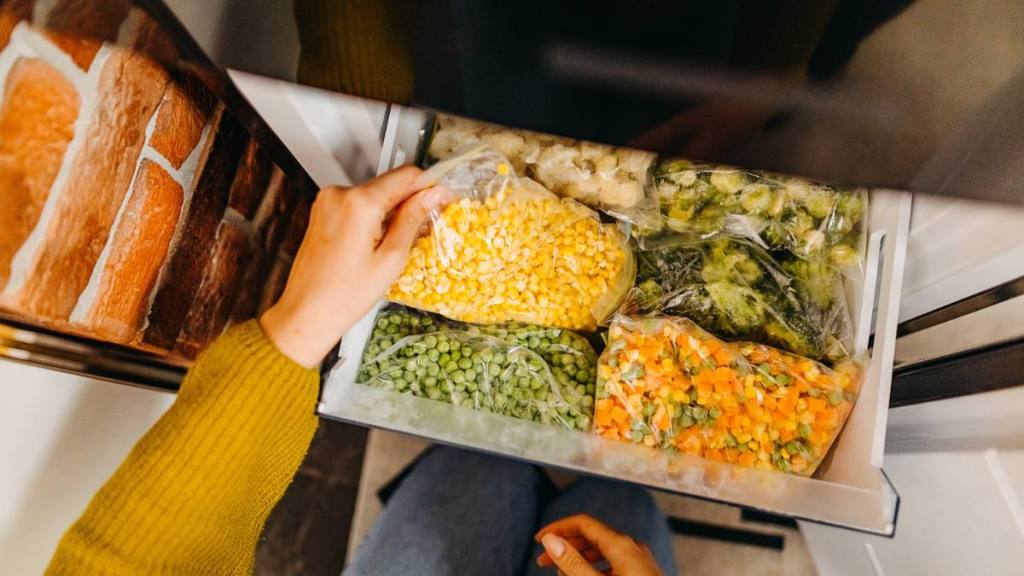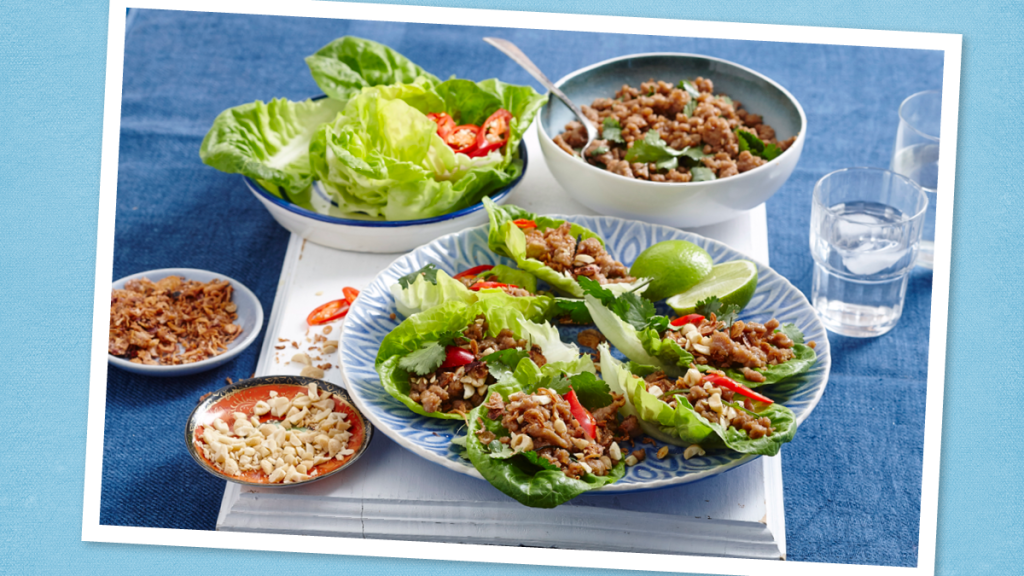How to Eat More Veggies: These Genius Tricks Make It So Easy to Get All the Health Benefits
Stocking your fridge with leafy greens and crisp carrots is only half the battle!

Improved eyesight, lower blood pressure, reduced risk of cancer, healthier digestion…it seems like every week a new study reveals yet another way vegetables improve our health and longevity. The effects are so powerful, physicians are starting to write “produce prescriptions” for patients at risk for metabolic or cardiovascular disease — and they’re seeing exciting results. But what to do if veggies are last on your list of favorite foods — or you find them too time-consuming to prepare? Try these 11 plant-powered tips and tricks for how to eat more vegetables.
How many veggies should we eat a day?
An analysis from Harvard found that the ideal “dose” of vegetable consumption is three servings per day of leafy, green and carotene-heavy veggies like carrots and peppers (as opposed to starchy veggies like peas, corn and potatoes, which were not shown to improve health.) This amount correlated with a 12% lower risk of death from heart disease or stroke, a 35% lower risk or death from respiratory disease and a host of other benefits. So what counts as a serving? Approximately 1 cup of a raw vegetable or ½ cup cooked.
How to eat more vegetables
We talked to foodies, nutritionists and other pros for their best tips. Read on for the best ways to get your daily dose.
1. Get maximum flavor from frozen

You might have heard the advice to stock up on frozen veggies so you always have a healthy, affordable option at hand. The hitch: When prepared typically, frozen vegetables can taste (and look) pretty blah. Clinical nutritionist Kelly LeVeque, who has worked with Jennifer Garner and Jessica Alba, has a genius fix: First, heat frozen broccoli, cauliflower florets or green beans on a sheet pan in the oven for 10 minutes to evaporate their excess water. Then, toss them in olive oil, season with salt and pepper or your favorite herbs and roast again until just crisp.
2. How to eat more vegetables: toss ‘em in the air fryer
“Air Fryer Queen” Cathy Yoder has taught millions to make everything from croutons to fried pickles in their air fryers. So when she shared which veggies benefit most from the air-fry treatment, we listened. Her #1 pick is zucchini fries, made extra-crisp by slicing out the seeds that can lead to sogginess and tossing in a cheese-and-crumb topping.
Watch her make it here:
Runners up include Buffalo Cauliflower, which gets tossed in its sauce halfway through its time in the machine, and kid-approved Bacon Brussels Sprouts coated with maple syrup and avocado oil. Each air fryer veggie preparation only takes about 10 minutes.
3. Add stealth nutrition to favorite recipes
If you have picky eaters in your house, try sneaking vegetables into dishes. Here, a few easy ideas:
- Line tacos with lettuce: Nestle large romaine leaves in your taco shells before adding other ingredients and all you’ll notice is the extra crunch!
- Slip slaw into chicken soup: Toss a handful of bagged shredded white cabbage (for coleslaw) into chicken soup. It’s so mild it will disappear into the broth.
- Blend greens into a smoothie: Unlike kale, bunches of baby spinach leaves disappear into a smoothie, as do slices of peeled cucumber. And riced cauliflower works wonders to make a smoothie extra-creamy — without any cauliflower taste. Or, for maximum nutrition in the smallest package, add well-washed microgreens to your blender.
- Hide crucifers in casseroles: Substitute half the rice in your dish with cauliflower rice and they’ll be none the wiser.
Related: 12 Taco Tuesday Recipes That Make It Easy Turn Any Night of the Week Into a Fiesta
4. How to eat more vegetables: think decadently

What’s in a name? Apparently quite a bit when it comes to veggies. Twisted citrus glazed carrots… Slow-roasted caramelized zucchini bites… Dynamite chili and tangy lime-seasoned beets… These are the decadent descriptors Stanford researchers found made people consume significantly more vegetables. In fact, participants ate 41% more of foods when they were presented with adjectives that spotlighted flavor and indulgence versus phrases like “no added sugar” and “lighter choice.” To harness this magic marketing trick in your kitchen, put away diet cookbooks and look for recipes with gourmet names, luxurious seasonings and flavorful techniques like roasting, pickling and glazing. (We’ve got several here!)
5. Try this kid-tested trick
A study found that children aged 6 to 11 ate significantly more fruits and vegetables when a meal lasted approximately 10 minutes longer than the norm (30 minutes in total). While researchers aren’t sure why meal duration is so meaningful, one theory is that the slower pace increases satiety and distracts from the siren call of dessert, allowing children to sample a broader range of foods. Why not do like the French and enjoy your own unhurried breakfast, lunch or dinner — and make that meal the most packed with vegetables to encourage maximum intake.
6. How to eat more vegetables: find your favorite dip
While we’ll never tire of an amazing hummus or unctuous pesto, there’s a whole world of dips waiting to be explored—and many are as healthy as the crudite or roasted veggies you’ll pair them with. Try a zingy chimichurri, a garlicky aioli, a cheesy bean dip, a vegan queso, a fire-roasted baba ghanoush, an edamame mash or a cooling tzatziki and get dipping!
Related: 12 Delicious Savory and Sweet Appetizer Dip Recipes
7. Shake, don’t toss
Love ‘em or hate ‘em, the Kardashian women can teach us a thing or two about salad. Their propensity for shaking salads to evenly distribute dressing has become an iconic part of their reality shows — so much so that the ladies gave viewers an amusing tutorial.
Try it by layering your ingredients in a securely closed lidded bowl (buy on Swell, $40.00) Tupperware container or domed cup (buy at Walmart, $5.69) and shake, shake, shake.
8. How to eat more vegetables: prevent spoilage in seconds
Sometimes we avoid buying veggies because we’re worried they’ll rot before we use them. Luckily, a few quick interventions can make them last twice as long. Beets, carrots and radishes, for example, look tempting with their leafy tops, but those fronds will start to pull moisture from the vegetable in a few days. A quick “haircut” before storage will keep them crisper and firmer for several days, shares Amanda Hawkins, food expert at Misfits Market. Kale, chard and other leafy vegetables will get parched and wilted if left unwrapped in the fridge. Wrap them loosely in foil to retain their texture, then reuse the foil on the next bunch.
Related: How to Clean Fruit So It’s Safe to Eat + The One Thing You Should Always Skip
9. Seek out these supermarket trends
- Okra crisps: Popular in the South and Texas, these yummy snackers are made by oven- or freeze-drying young okra pods. Find ‘em nationwide in Trader Joe’s and Whole Foods stores, or order direct from vendors in South Carolina and Missouri. Please pass the ranch!
- Ready-to-eat beets: Raw beets take a while to peel, cube and cook, which is why the vacuum-sealed steamed beets now available at Safeway, Fred Meyer and Giant are such a find. “This is one of the only times I recommend buying pre-cooked veggies,” says Robert Schueller, produce guru at Melissas.com. “They’re simply delicious!” Find beets a bit too earthy? Look for pre-steamed golden beets, which have a milder flavor. Adventurous eater? Go for the brand-new pickled beets.
- Veggie pulp chips: Shark Tank-approved brand Pulp Chips partners with juice bars to upcycle the pulp that’s leftover from juicing (which containers 95% of the fiber in whole veggies). Crunch-tastic flavors include Barbecue, Salt ‘N’ Vinegar and Jalapeno Lime.
10. How to eat more vegetables: upgrade your containers
We know that washing, chopping and storing veggies ahead of time will make us likelier to eat healthfully throughout the week, but all that prep can start to feel tedious — and after a few days we might not be thrilled by a salad in a sad old container… That’s why TikTok’s favorite meal prep expert Kelsey Riley loves using the most beautiful tools and storage she can find to make her prepped veggies look amazing. After all, who wouldn’t rather take lunch to work in a chic pink bento box?
Watch Kelsey prepare her veggies in her favorite containers here:
11. Establish lasting habits
When you want to make a big behavior change, it can help to walk through an “information and self-regulation” strategy on your own or with a therapist, says psychologist Alice Boyes, PhD. In one study, this technique resulted in 20 to 32% increases in fruit and vegetable consumption in women aged 30 to 50, and the results persisted after two years. Follow Boyes’s breakdown of each step — including writing down your goal, noting your likeliest obstacle and brainstorming what you can do to overcome it — to try it yourself.
For more ways to get your daily dose of veggies, keep reading:
This Cooking Hack for How to Chop Vegetables with a Pizza Wheel is Food Prep Genius
This Common Kitchen Tool Can Also Make Fresh Fruit and Vegetable Juice
Want Your Roasted Vegetables Extra Crispy? Put Your Pan on the Oven Floor













